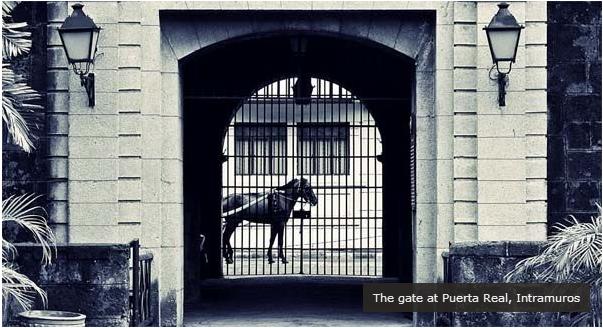Published on July 30, 2010

Tucked among the many districts that comprise Metro Manila, lies a walled medieval city called Intramuros. Roughly translated as “within the walls”, Intramuros was built by Spanish settlers in 1571 and offers a glimpse at how the city of Manila came to be. Its exact location stands over the original Islamic settlement of Maynila; even before the coming of the Spanish, the settlement of Maynila was bustling with Islamic nobility and Chinese merchants.
A good start when exploring Intramuros is Fort Santigao. This defensive fortress was the Philippines’ center for the Manila-Acapulco spice trade. Over the course of four centuries, the fort’s dark and decrepit dungeons housed a cast of criminals and rebels. Today the dungeons and the ammunition room are completely closed off to the public, but you can take a quick, albeit haunting, glance inside.
Among the fort’s residents was the National Hero, Jose Rizal, who was imprisoned for writing two novels which sparked the Philippine Revolution. There are now two museums within Fort Santiago that showcase many of Rizal’s personal belongings, as well as inscriptions of his final poem, “Mi Ultimo Adios” (“My Last Goodbye”).
Traces of Rizal’s imprisonment can be found throughout Intramuros. Starting at Fort Santiago are bronze representations of the steps which he took to his execution in nearby Luneta Park. His footsteps can be traced around Intramuros, leading to fascinating sights including the ruins of a small Catholic church as well as another set of ruins which have become a hangout for local skaters and some of Manila’s finest graffiti artists.
The are two ways to get around Intramuros. First, is by foot. While the heat, depending on the season, may be a factor, it does allow a generous amount of time to take in all the sights and the history Intramuros has to offer. The second is through the famed Kalesa. The horse-driven carriage can be found all over the bay-area, Manila district. The drivers are usually knowledgeable and will share their own views on Filipino History. However, be prepared to haggle with some of them.
Down the street from Fort Santiago stands the San Augustin Church, which is known as the final resting place of Miguel Lopez de Legaspi, the first Governor General of the Philippines. A quick glance at the ceiling reveals a seemingly 3D image painted by Italian trompe l’oeil artists. The church’s museum is a good place to learn about Catholicism’s influence in the development of the Philippines.
Across the street from the church is the Casa Manila, a great place to discover the effect that foreign influence has had on Philippine culture and society. The building is a showcase of what a traditional upper class home would have looked like in the 19th century. The donated antiques tell a rich story of the locals’ struggle for acceptance among their colonizers. Perhaps the most interesting part of this tale concerns the wave of Chinese immigrants who settled during the time of the Muslims.
After centuries of battling the Spanish, which often involved the trading of cannon fire between Intramuros and nearby Chinatown, the Chinese merchants eventually assimilated with the Spanish colonists. Soon, they began adapting Spanish culture: learning the language, converting to Catholicism, and switching around the vowels of their names. In time, Chinese names such as Zon-Tua and Pin-Ong, were Hispanized to Tuazon and Ongpin. These families, along with the Cojuanco’s and the Tantoco’s are now at the center of Philippine high society.
Despite the appearance of global fast food and cafe franchises within its walls, Intramuros remains the only corner of Metro Manila to evoke the city’s Spanish colonial past. For locals and tourists alike, the walled city allows one to breathe, discover, and understand the origins the Philippine capital’s unique Spanish influences. In the end, Intramuros stands as a testament to Filipino history and culture; a strange mix of east and west, with a little bit of this and that, and it works.
Born and raised in the eclectic quarters of Metro Manila, Mike Litton is a freelance writer and host of an online show called ‘ATGSITE: And The Geeks Shall Inherit The Earth’. He is currently working on his first novel,‘Mixtapes’.





